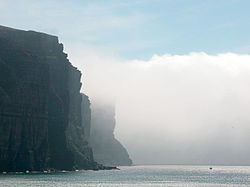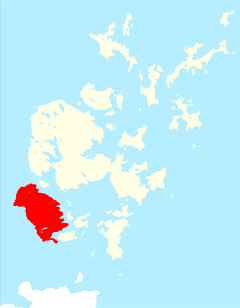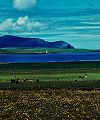Hoy
| Hoy | |
 Cliffs on the Atlantic coast of Hoy | |
|---|---|
| Main village: | Lyness |
| Location | |
| Grid reference: | ND263961 |
| Area: | 55 square miles |
| Highest point: | Ward Hill, 1,572 feet |
| Data | |
| Population: | 272 |
Hoy is an island in Orkney. With an area of 55 square miles, it is the second largest in the group, exceeded only by Mainland. It is also unique in Orkney in its mountainous landscape
The island's name, in common with the other isles of the county, is from Old Norse, named Háey in the sagas, which means "High Island". This is a good description, for Hoy is like a small piece of the Highlands dropped in the sea in contrast to its neighbours, albeit that the size of the island does not give its hills a chance to rise to anything like the heights achieved in the Highlands.
The highest point in the county of Orkney is on Hoy; Ward Hill, Hoy, reaching 1,572 feet.
Hoy is connected by a causeway called The Ayre to South Walls.
The island
The dramatic coastline of Hoy greets visitors travelling to Orkney by ferry from Caithness on mainland Great Britain.
Hoy has extremes of many kinds including some of the highest sea cliffs in the United Kingdom at St John's Head, which reach 1,150 feet.[1] The impressive and famous sea stack, the Old Man of Hoy stands out from this coast. Hoy has some of the most northerly surviving natural woodland in the British Isles and there is said to be a remote possibility that Arctic char survive in Heldale Water. The most northerly Martello Towers stand here too, which were built to defend the area during the Napoleonic War but which were never used in combat.
The highest point in Orkney, Ward Hill, is found on Hoy.
The main naval base for the British fleet Scapa Flow in both the First and Second World Wars was situated at Lyness in the south-east of the island. Some rather incongruous art deco structures nearby date from this period.
An unusual rock-cut tomb, the Dwarfie Stane, lies in the Rackwick valley in the north of the island. It is unique in northern Europe, bearing similarity to Neolithic or Bronze Age tombs around the Mediterranean. The Dwarfie Stane is very small and local legend had it that it was carved by dwarves, hence the name.
In Norse mythology, Hoy is the location of the never-ending battle between Hedin and Högni.
Ferries serve the island with two routes: one links Lyness on Hoy and Longhope on Walls with the island of Flotta and Houton on Mainland. The other links Moaness in Hoy to the island of Graemsay and Stromness on Mainland. The ferries from Caithness pass by Hoy's coast and around the headland, but do not dock at Hoy.
Hoy is part of the "Hoy and West Mainland National Scenic Area".[2]
Wildlife
The northern part of the island is an RSPB reserve due to its importance for birdlife, particularly great skuas and red-throated divers. It was sold to the RSPB by the Hoy Trust for a minimal amount.[3] Anastrepta orcadensis, a liverwort also known as Orkney Notchwort, was first discovered on Ward Hill by William Jackson Hooker in 1808.[4][5]
Picture gallery
-
The Old Man of Hoy, seen from the south
-
Rackwick valley
-
Rackwick
-
Scapa Flow Visitor Centre
-
Hoy High Lighthouse on Greamsay viewed from Mainland
Outside links
References
- ↑ Haswell-Smith, Hamish (2004). The Scottish Islands. Edinburgh: Canongate. ISBN 1841954543.
- ↑ "National Scenic Areas". SNH. Retrieved 30 Mar 2011.
- ↑ Haswell-Smith, Hamish (1996). The Scottish Islands. Canongate. p. 283. ISBN 0 86241 579 9.
- ↑ "Bryology (mosses, liverworts and hornworts)" Royal Botanic Garden Edinburgh. Retrieved 15 May 2008.
- ↑ "West Highland Mosses And Problems They Suggest" (January 1907) Annals Of Scottish Natural History 61 p. 46. Edinburgh. Retrieved 11 June 2008.
| Islands of Orkney |
|---|
|
Inhabited islands: |





